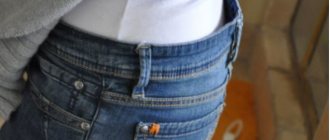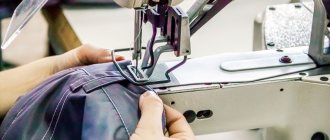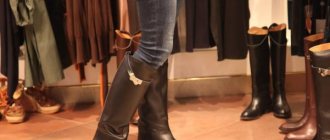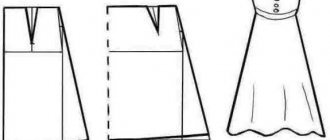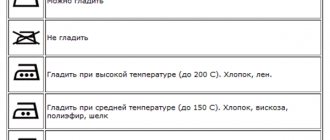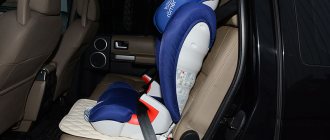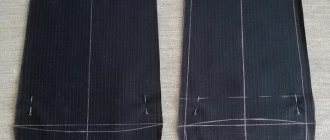How to sew jeans, but don’t want to go to a tailor? Master classes on reducing a product by one or more sizes will come to the rescue. The instructions will help you understand the essence of the procedure and carry it out yourself with or without a sewing machine. You can sew the pants along the side seams in the hip area, along the entire leg or just below the knee, as well as at the waist.
How to properly sew in the sides of men's and women's jeans?
Important: It’s worth saying right away that sewing jeans on your own is not as easy as it might seem at first glance. If you are not confident in your abilities, it makes sense to contact a studio. Otherwise, you can simply ruin the thing.
However, if you think that your sewing machine should not just gather dust, but work, you can try it. Just don’t forget, this is the same case when they say “Measure twice, cut once!” .
How to sew jeans yourself
To work you will need:
- Sewing machine
- Scissors
- Tailor's pins
- Threads
- Overlock
- Steamer
- Chalk or bar of soap
- Iron
First, try on your jeans to decide where you need to sew the product. If you need to remove excess tissue only on the sides, this is one way, but if you need, for example, to sew in the hips, there will be a different technique.
Let's discuss all the options one by one. Let us immediately note that women's and men's jeans are sewn in the same way.
You can often find extremely simple tips on how to quickly sew in the sides of jeans. The idea comes down to this: place a model that fits your size on top of your old jeans, cut off the excess and stitch. Of course, this should never be done.
Important: You won’t be able to sew the jeans only along the side seam; you must sew both the side seam and the inside. Otherwise, the product will turn out twisted.
If your jeans fit perfectly at your waist and you need to remove some fabric from the sides, you can do this:
- Put your jeans on with the wrong side facing out.
- Using tailor's pins, mark the places where you need to sew, first on one leg.
- Do this with the inner seam and the outer seam.
- Without ripping or cutting anything, remove the jeans.
- Use chalk or soap to mark a line for the stitching.
- Sweep the product by hand.
- Try on the jeans again, sit down, walk around.
- Make sure your jeans fit properly.
- Only after this can you cut off the excess 1 cm further from the future seam.
- Now it’s time to machine stitch the jeans with threads that match the color.
- Sew a finishing stitch along the outer edge of the jeans using double thread.
- Iron your jeans thoroughly.
- Finish the cut edges with an overlocker.
Sewing jeans: step 1
Sewing jeans: step 2
Sewing jeans: step 3
Sewing jeans: step 4
Sewing jeans: step 5
How to narrow your jeans at home yourself
Recommendations for sewing jeans
If you don’t want to go to a tailor, you can easily alter your jeans yourself. Useful lifehacks will help you do everything right:
- Be sure to iron the seams as you work. Do the same after completion to return the trousers to their original appearance and smooth out any protruding seams.
- Work with pants that are clean but already worn. This way you will understand how much jeans can stretch. But keep in mind that the product will shrink after washing.
- Don't neglect finishing the edges. This will prevent the fabric from fraying and extend the life of the item.
- Don't do the job hastily. Each sub-item must be included (measurements, basting, etc.). This will help avoid damage to the product.
- Don't strip off excess. Not everyone can fully sew an item.
- Select threads carefully based on color and strength. For denim, it is advisable to buy special ones - they are reliable.
- Be sure to remove old threads from the fabric, otherwise they will ruin the look.
- If you don’t want to waste time on long fittings, then use the method of using a second product that fits your figure perfectly. If you have such jeans in stock, then you just need to remove the pattern from it and transfer it to a wide model. Another option is to attach the item to the pants being altered and make notes.
How to sew jeans in the hips?
You can try sewing jeans only at the hips. This is appropriate in the case when the hips are narrow, and only in the hips are the jeans too big, but on the legs they fit normally.
Important: You can sew in jeans at the hips if you need to remove no more than 4 cm. Otherwise, you will have to flog the codpiece, which is often beyond the power of a novice needlewoman.
You can sew in jeans by a few centimeters
You can remove excess tissue on the hips in this way:
- Open the side seams.
- Open the middle seam in the buttock area.
- Sew taking into account the necessary preliminary measurements.
- It is necessary to sew the edges strictly in the same style as the old seams, otherwise it will look ridiculous.
Important: It is almost impossible to sew finishing stitches without experience. Therefore, we suggest that you familiarize yourself with this process by watching the video tutorial.
Suturing in the thigh area
If the pants are wide at the top of the legs, it is advisable to sew along the side seam.
For this:
- Put on your pants with the inside out.
- Mark with pins how much fabric needs to be removed.
- Remove the product, draw lines under the ruler with a pencil (chalk or soap).
- Open the belt and pockets.
- Open the side seams.
- Baste new ones along the lines.
- Using a machine, stitch along the marks from the inside and make 2 lines from the face.
- Be sure to overlock the edges and iron the product.
If the measurements are taken correctly, the pants will fit correctly.
Video on the topic
How to sew jeans on the butt along the back seam at home?
To sew the back seam of jeans, you will need the sewing tools listed above. It will not be possible to sew the jeans by hand in this place.
So let's get started:
- Start by putting on jeans.
- It is inconvenient to make bastings in this part of the body on your own; ask someone to help you remove the excess and make bastings with pins.
- Then you need to undo the belt.
- After which you will have to rip the back seam, it is not difficult to rip it out.
- Using a ruler, measure the same distance between the old seam and the pins on both sides.
- Use soap to draw a cutting line, don’t forget to leave a 1 cm allowance.
- After this, baste the seam, then try on the jeans.
- If the jeans fit well, you can sew the seam using a machine.
- Finish the cut using an overlocker.
- Make finishing stitches on the front side.
How to Taper Jeans at the Back Seam
Jeans need to be ripped at the seam
How to sew jeans on the butt
Now you need to properly trim the belt:
- Shorten it to the required length by cutting the fabric on both sides.
- Sew the sides of the waistband together.
- Then sew the waistband to the jeans and make a finishing stitch.
Finishing the waistband is the final touch to sewing jeans along the back seam
Reduction using waist darts
For a figure with a large buttock, you may need to add waist darts to the back halves of the jeans.
Step-by-step processing has its own characteristics:
- After ripping off the belt, waist darts are placed on the back halves. Their solution is equal to half the reduction, but not more than 2 cm. The length of the dart should not be greater than the width of the yoke on a classic cut.
- Stitched darts are sewn with a single finishing stitch.
- The middle seam remains unchanged. The appearance of hemmed jeans does not change.
- The belt is ground down and, as a result, stitched to the assembled parts of the back halves. Just like in the previous treatment, the belt loop hides all the repair details.
The method of reducing jeans leaves the original processing of the middle seam of the back halves unchanged, but waist darts are added. In this case, there is a chance for a figure with a pronounced individual feature to easily achieve an ideal fit.
How to sew jeans in the waist, belt?
If the jeans are too big at the waist, it is best to sew them in as described above - along the back seam. If everything is done correctly, they will sit well on the butt.
If your jeans are too big in the waistband and you don't want to bother, you can narrow the waistband a little in an easier way.
You will need:
- Rubber
- Scissors
- Sewing machine
- Regular pin (in other words, safety pin)
Let's get started:
- Take a small piece of elastic. The length depends on how much you want to shorten the belt.
- Make slits in the belt in two places (the distance between the slits is several cm longer than the elastic band).
- Now thread the pin through the elastic and pull it and the elastic between the slits.
- Pin it to the jeans so that the end of the elastic does not “run away”.
- Using a sewing machine, make two stitches at both ends.
How to sew elastic into jeans
Make holes with a ripper
Pull the elastic band inside
Stitch the edges of the holes
How to sew jeans into a waistband: before and after
WHAT YOU NEED
Machine needles for denim and its analogues – gin (jean), chambry, stretch, eikru and broken twill are called “jeans” or HJ (jeans). There are also RG markings with numbers from 90 to 110, the standard for household machines is 130/705H. Needles for denim are usually marked with a blue stripe. If there are two stripes on the needle, then you should focus on the top one, located closer to the flask. However, if you decide to suture a thin chambry, you can use regular needles marked “H”.
Threads for sewing denim will require increased strength; reinforced ones are best. Regular cotton, unless it is specially made for sewing coarse fabrics, can quickly wear out and after a couple of washes the stitching will have to be renewed.
Full list of tools and equipment for work:
- pins for fitting;
- centimeter and ruler;
- needle, thimble and thread for basting;
- seam ripper;
- scissors;
- tailor's marker or chalk;
- threads for internal seams and finishing stitches in the color of the original (No. 40 from Gütermann);
- elastic band with a width slightly less than the width of the belt (for option No. 3)
- sewing machine with a needle from No. 90 to 110 (depending on the thickness of the denim);
- hammer for beating off thickened seams (for dense and hard fabrics);
- iron.
How to sew and narrow the legs of flared jeans, straight to skinny at home?
Nowadays, unfashionable flared jeans can be narrowed and you get modern skinny jeans.
Important: You should not try to make skinny jeans out of flared jeans if the flare is initially too wide. The cut is completely different, the result will not please you.
It makes sense to narrow the flare by a few centimeters (3-4 cm). In this case, arm yourself with sewing tools and get to work:
- Iron your jeans and try them on.
- Have someone help you use pins to mark the inseam and crotch.
- Open up the hems, as well as the side and crotch seams.
- Mark the seam lines with chalk or a bar of soap.
- Leave a centimeter allowance.
- Trim off excess fabric.
- Hand baste the seams.
- Try on the jeans again, walk around in them, try to sit down.
- If everything fits, you can sew the seams on a machine.
- Finish the edges with an overlock or zigzag stitch.
How to sew flared jeans
Flared jeans need to be sewn on both sides
The finished result
Required Tools
How to make jeans narrower, and what tools are needed for this? For high-quality work you will need a fairly large amount of materials. Denim fabric is dense, as are the seams, so you need to work with it carefully. Some tools are selected just for this density. In order to make jeans narrower, you will need:
Required Tools
- Electric sewing machine.
- If possible, use an overlocker for stitching. If it is not there, use the zigzag mode on the machine.
- Scissors. For thick fabrics, tailor's ones are best.
- Chalk or bar of soap.
- Threads and needles for sewing.
- Long ruler or centimeter.
- Iron.
If you don’t have tailor’s scissors, you can take regular ones, but working with them will be a little more difficult, especially when cutting seams.
How to sew men's and women's jeans one size smaller?
Important: You can sew jeans one size smaller, maximum 2 smaller. It's easier to sew new jeans than to sew them up more than 2 sizes.
If you do take the risk, be prepared to completely reshape your jeans.
To downsize your jeans, put them on and look closely at where exactly they fit unflatteringly.
Try to choose the simplest method of remodeling, with minimal investment of labor and the best possible result.
There are several ways to change jeans to a size smaller:
- Cutting off the excess on the sides and inside seam.
- Sew the product along the back seam.
- Remove a little in the hips only on the sides.
A few simple rules for successfully sewing jeans:
- Jeans, both women's and men's, are altered according to the same principle.
- Before starting work, wash the product and iron it.
- It is advisable to find an assistant (-tsu) to help you make correct and even outlines.
- Do not rush to cut off the excess; it is better to finally make sure that you are doing everything correctly.
- Remember, there are some models that cannot be recut.
How to sew jeans to size
Jeans with zipper
Another technique will completely change the appearance of the product. Some fashionistas sew a zipper into the stitching at the back. Many will decide that jeans with a zipper at the back will look vulgar, but young people decide that it is stylish and very original.
Much depends on the degree of athleticism of the buttocks of their owner, the presence of decor in the place of the fastener. In order not to shock others, you can sew the fastener not through the entire back seam, but only from the top.
What you might need to sew a zipper into jeans:
- metal lock;
- threads in the color of jeans;
- needle, thread;
- sewing machine.
You can decorate jeans like this yourself:
- Choose a zipper of suitable length;
- Open the back seam to the desired length by cutting the waistband;
- Baste the fastener bands, then sew them on a sewing machine;
- To prevent the zipper from unfastening at the top, you can sew a metal hook and loop on the inside.
If you decide to take this step, you need to be prepared for the fact that the zipper may open.
How to reduce the waist of jeans without a sewing machine?
The above tips are suitable for those who have a sewing machine. If you do not have the opportunity to machine sew your jeans, you can resort to other methods:
- Wash the product in water at a temperature of 90°, the fabric will shrink for a while, however, then the jeans will become too big again.
- Choose a suitable belt if you only need to gather it at the waist.
- Sew the elastic into the waistband by hand.
In principle, it is possible to sew the trouser legs by hand, but it will not look aesthetically pleasing, and finishing stitches cannot be done by hand either.
Finally, I would like to say that if you are not sure of a good result, it is better to take your expensive item to the studio, the professionals will do everything right. However, following these tips, you can sew up your jeans so you can wear your favorite item again. We hope everything works out for you. We suggest watching the video to better understand how to alter jeans.
The simplest option
You can fit large jeans to your child's waist yourself and without using a sewing machine.
What you need for work
To do this, it is enough to prepare:
- 0.5 m of elastic, 3 cm wide;
- sharp small scissors;
- indigo thread No. 40;
- hand sewing needle and thimble.
First, let's try on the pants. The fitting must be in suitable shoes, the T-shirt and shirt are tucked inside
Step-by-step execution
Step-by-step instructions include the following points:
- We fasten the elastic band over the belt with pins so that it securely holds the jeans at the waist, and its ends are located at a distance of 10-12 cm from the fastener button.
- On the wrong side, at the location of the ends of the elastic, we make vertical cuts on the inside of the belt. The length of the cut is equal to the width of the elastic band being threaded. We process the cuts with a “back needle” overlock stitch. As a result, the fabric does not fray. Now you can start installing the elastic band.
- The threaded elastic band is sewn right through to the waistband of the jeans. The seam will be strong and neat.
If it is possible to use a machine, this will be the only operation in this technology using sewing equipment.
A simple way to reduce pants will help when you need results urgently, for example, on the road. The method will also help out during unplanned weight loss, when there is no point in changing your wardrobe and the lost kilograms will soon return.
The best part is that the elastic band can be removed at any time and the product will return to its original size.
Do they need to be redrawn and how?
If you need to reduce your pants by 3 or more sizes, you will have to cut them again. Before you start, you should soberly assess your strengths so as not to spoil the thing. If you have the slightest doubt, you shouldn’t take risks; it’s better to trust the professionals and take your panties to a tailor.
A reduction of 3 sizes is carried out at the waist, hips and groin. The first step is to carefully rip the product open using a ripper, nail scissors or a blade. First, the lining of the belt in the area of the seat seam, the seat seam itself, and the crotch seams are ripped off to the level of the hips. Remove threads from edges and iron. Mark points:
- the ends of the belt, in accordance with the measurement of waist circumference;
- rear width along the step line;
- width of the back along the hip line;
- connect the resulting points with one line using chalk. It will duplicate the cut line. Place basting stitches along the chalk line. Try it on. If it fits well, then stitch along all the edges. Iron well;
- straighten the lining of the belt and hem it to the edge in the area of the seat seam;
- iron everything.
When a product needs to be sewn in 4 or more sizes, the trousers are completely recut . That is, they rip out all the seams completely, get rid of the threads, iron them, re-cut them, cut off the excess and grind them down in the same way as during the initial sewing.
Proper drying
Proper drying of denim trousers will help secure the shrinkage result.
There are three ways:
Jeans, after washing in hot water, are hung on the dryer bar without straightening or stretching.
It is important that the dryer is located near a heat source (radiator or heater). Then the water from the denim will evaporate faster, recording the result of shrinkage.- Wet jeans are laid out on a terry towel. The fabric will quickly absorb moisture, which will help the trousers dry without losing their shape.
- Iron drying is a good method if you need to reduce localized areas. The jeans are turned inside out and ironed in the necessary places with a hot iron. If you don't have an iron at hand, a hairdryer is a good alternative.
- The fastest and most effective way to dry jeans is to use a special drying machine. Such hot air drying will help reduce jeans not by one, but by two sizes.
This article will tell you about ways to dry jeans.
Features and types of fabrics
This classic version of this material, popular for everyday clothing, is created by twill weaving two types of cotton threads: dyed and white. The result is a canvas that is colored on one side and light on the other. This fabric is most susceptible to stretching and at the same time is easily restored by wet-heat treatment. The culprit is cotton, the fibers of which are very strong but can elongate.
Advice! High-quality jeans do not increase by more than half a size during wear. Pants with a cotton content of 70% or more are comfortable.
Since the first denim products, many varieties of this fabric have been created, some of which only vaguely resemble jeans. They all differ in appearance and features that appear in the sock. One of the successful inventions is denim stretch, which easily stretches, perfectly fitting the figure.
Important! Stretch jeans cannot be shrinked using wet-heat treatment, because this will damage the elastic fibers, and the material will be stretched even more and deformed.
Why do jeans stretch?
Denim material is made from durable and thick cotton thread. It is strong to tear, but stretches well. Because of this, with constant stretching of the fabric, jeans lose their original shape. This is especially noticeable on the knees (those unattractive bubbles) and waist. Adding synthetic threads improves the situation slightly. They are rubberized and therefore return more easily to their original shape, maintaining elasticity.
These details are of important practical importance. Stretch jeans, which are usually made with a high synthetic content, practically do not shrink after a hot wash. The best way to reduce them is to suture them. More natural denim (70% cotton or more), on the contrary, shrinks greatly from high temperatures. Therefore, jeans with a small percentage of synthetic fibers or no synthetic fibers can be washed to reduce them by size.
Check the fabric content on the tag
